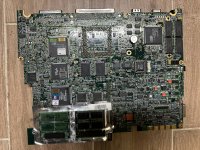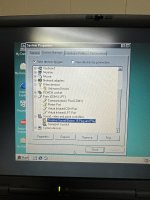Thanks for the detailed video. I am out of specific ideas; if I had the system, I would start to more-or-less randomly try various things until I get more information. Also, I would completely remove Windows from the equation. If sound does not work in DOS, then Windows won't make it work either.
Note 1: Your CMOS battery is low. Even though your BIOS appears to work correctly, the actual hardware configuration may not fully apply or get lost between reboots. I have an Acer 486 notebook with heavy issues unless the CMOS voltage is high enough and stable.
Note 2: You can set the audio resources in the BIOS. Can you verify whether anything is actually mapped when the BIOS starts booting (i.e. Shift+F5). Starting with AdLib (which has the easiest interface). In DEBUG, what do you get when running "I 388"? Can you get any AdLib audio to work?
Note 3: You started Windows before running Doom. Windows may mess with the PnP setup and may accidentally or intentionally unconfigure the card. Try your DOS test before ever starting Windows (again, Shift+F5 or an empty CONFIG.SYS with only HIMEM.SYS loaded).
Note 4: Does anything change on the DOS side of things if you set the BIOS option "PnP OS" to "Yes"?
Note 1: Your CMOS battery is low. Even though your BIOS appears to work correctly, the actual hardware configuration may not fully apply or get lost between reboots. I have an Acer 486 notebook with heavy issues unless the CMOS voltage is high enough and stable.
Note 2: You can set the audio resources in the BIOS. Can you verify whether anything is actually mapped when the BIOS starts booting (i.e. Shift+F5). Starting with AdLib (which has the easiest interface). In DEBUG, what do you get when running "I 388"? Can you get any AdLib audio to work?
Note 3: You started Windows before running Doom. Windows may mess with the PnP setup and may accidentally or intentionally unconfigure the card. Try your DOS test before ever starting Windows (again, Shift+F5 or an empty CONFIG.SYS with only HIMEM.SYS loaded).
Note 4: Does anything change on the DOS side of things if you set the BIOS option "PnP OS" to "Yes"?


